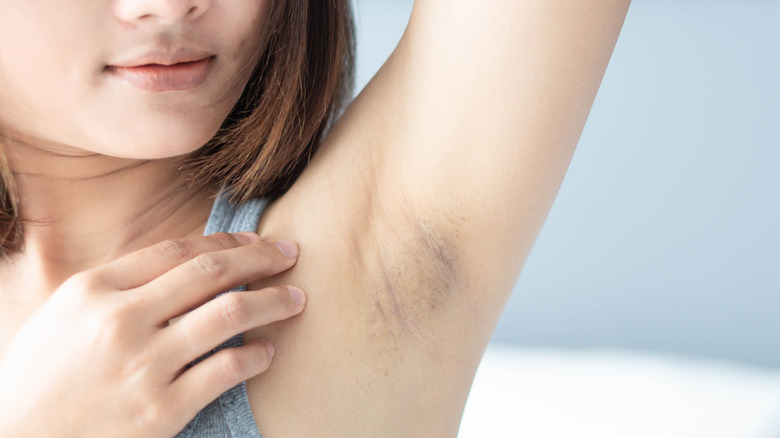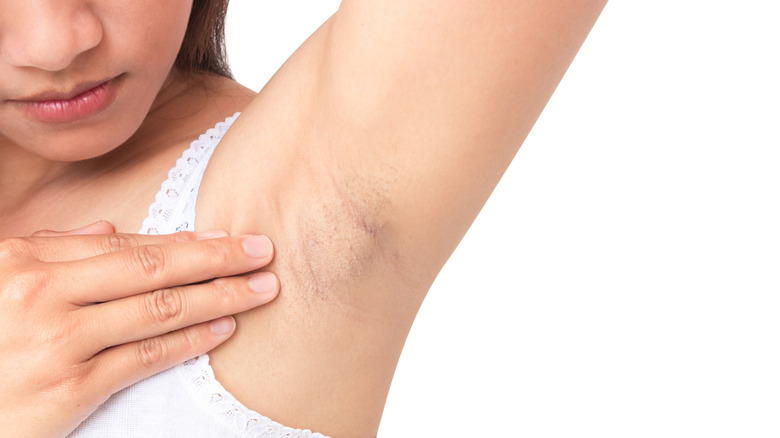What It Means If Your Underarms Are Dark (And What Can You Do To Treat It)
We're finally living in a time where underarm hair is slowly being considered the norm, especially in women. People used to balk at women who embraced their body hair, but now, beauty standards are changing, and many are beginning to accept that hair, wherever it may grow on one's body, is totally normal and something that no one should ever be ashamed of.
Still, some can't help but prefer having bright, hair-free, and blemish-free pits, and that's fine too. But one common aspect of maintaining underarms free of fuzz is occasionally dealing with dark patches or hyperpigmentation. Like any other part of your body, your armpits can have discoloration due to a variety of factors. And while darkness in this area is normal, it can also serve as a source of insecurity to some.
If you love wearing your tanks, tube tops, and bathing suits, it's understandable why you'd be concerned about having darker pits. But before you begin experimenting with brightening treatments, it's crucial to get to the root of the problem first.
Dark pits can be caused by a number of factors
Before anything else, it's important to understand that underarm discoloration should not be a major cause for concern. Dr. Nada Elbuluk, a board-certified dermatologist and associate professor of dermatology at Keck School of Medicine at USC, told Allure that most of the time, darker skin in areas like your underarms, elbows, and knees, is fairly common, and that "there's no need to try to lighten it because this is normal, healthy skin."
In terms of causes, though, one major factor is genetics. According to dermatologist Dr. Sheel Desai Solomon, those with dark skin are more susceptible to hyperpigmentation. "Many people develop darkened pigmentation under their armpits similar to the darker skin on the knees, elbows, groin, neck, or underbelly," she explained to Refinery29. Other times, it can also be caused by health conditions like polycystic ovary syndrome (PCOS) or diabetes. "Studies have shown that people with diabetes have a higher propensity to be affected, as insulin can interfere with pigmentation in the skin," she added.
And, of course, the products you use on your underarms can also affect its shade. Solomon noted that deodorants, antiperspirants, and other products that have aluminum, fragrance, and alcohol could cause skin irritation, leading to darker pits. Regular shaving can contribute, too, especially if you forego using shaving cream, use a dull blade, or shave your armpit hair too aggressively.
Treating and preventing dark underarms
If you want to reverse your underarm discoloration, there are plenty of ways to lighten them. But you have to be patient since the process can take weeks, months, or even years. "Whenever you are trying to correct pigmentation, time and patience are key," board-certified dermatologist Dr. DiAnne Davis shared with Real Simple, adding that, more often than not, regular exfoliation is the key to lightening the skin. "Gentle exfoliating scrubs can be beneficial, and ingredients, such as cucumber or aloe vera moisturize the skin and calm inflammation, which can be helpful as well." Meanwhile, Dr. Sheila Farhang told Today that if health-related issues are not what's causing the discoloration, you can go for other tried and tested ingredients like kojic acid and glycolic acid. But "if there is associated thickness of the skin, then I usually recommend urea [or] salicylic acid," she noted.
It also goes without saying that you should be careful with the products you use on your underarms. Refrain from using topical products that contain harmful ingredients, and always make it a point to moisturize the area to prevent dryness and chafing. And if you don't want to make the switch to waxing or laser hair removal, be sure to be careful when shaving, and only do so when the skin and hair are damp and/or moisturized.


